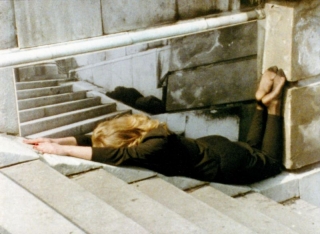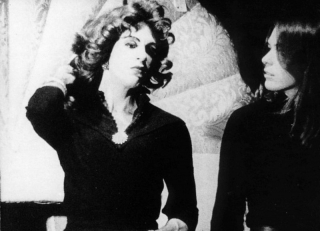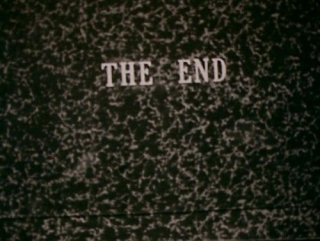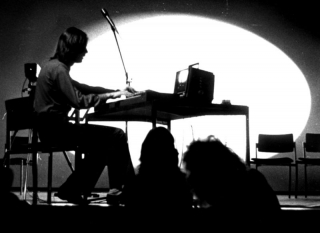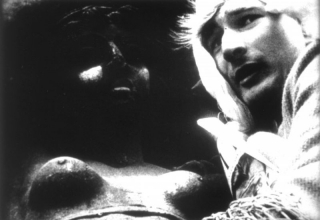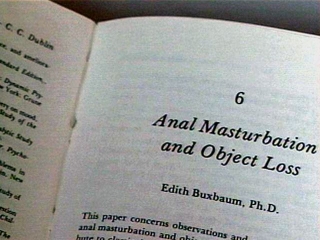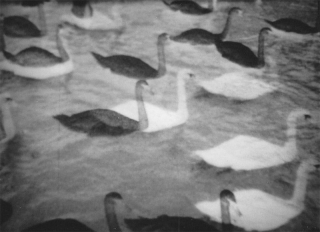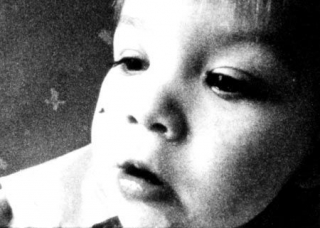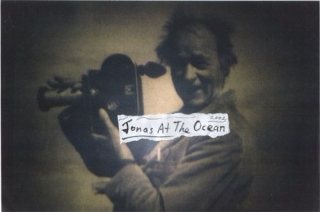Date: 3 June 2003 | Season: Essential Frame
THE ESSENTIAL FRAME: EARLY HISTORY
3 June—8 July 2003
The Essential Frame UK Tour: Programme 1
The origins of the movement, which rapidly matured into an authoritative investigation of the material of film and the formal aspects of its physical and intellectual application.
Peter Kubelka, Unsere Afrikareise, 1966, 13 min
Peter Kubelka, Schwechater, 1958, 2 x 1 min
Ernst Schmidt Jr., Filmreste, 1966, 10 min
Kurt Kren, 20/68 Schatzi, 1968, 3 min
Kurt Kren, 13/67 Sinus ß, 1967, 6 min
Hans Scheugl, Hernals, 1967, 11 min
Marc Adrian, Text 1, 1963, 3 min
Moucle Blackout, Die Geburt der Venus, 1970-72, 5 min
Valie Export, Mann & Frau & Animal, 1970-73, 8 min
Valie Export, Syntagma, 1984, 18 min
PROGRAMME NOTES
EARLY HISTORY
3 June—8 July 2003
UK Tour Program 1
UNSERE AFRIKAREISE
Peter Kubelka, 1966, 16mm, colour, sound, 13 min
“I play with the emotions and try to tear the emotions loose from people, so that they would gain distance to their emotions, to their own feelings.”
“I know of no other cinema like this. The ultimate precision, even fixity, that Kubelka’s films achieve frees them to become objects that have some of the complexity of nature itself – but they are films of a nature refined and defined, remade into a series of relationships. Those rare and miraculous moments in nature when the sun’s rays align themselves precisely with the edge of a rock or the space between two buildings, or when a pattern on sand or in clouds suddenly seems to take on some other aspect, animal or human, are paralleled in single events of a Kubelka film. The whole film is forged out of so many such precisions with an ecstatic compression possible only in cinema.” —Fred Camper
SCHWECHATER
Peter Kubelka, 1958, 16mm, colour, sound, 2 x 1 min
The material for the second of Kubelka’s ‘metric’ films came from a commission for a beer commercial. Through precise editing, the imagery is distilled down into a crystal shot of cinematic spirit.
“Schwechater lasts for one minute. It contains practically no plot, or only a negative plot. It contains elements with people who are drinking beer. This plot was enforced by external constraint. I simply was forced to film it. The plot doesn’t add any energy to the film. Nevertheless the film has an incredible visual energy. This minute possesses more visual energy than any other minute of film I have ever seen. Where does it come from? It is because I have broken with the old aesthetic, the old rules of film making, which say that film is movement. On the screen there is not any movement. Film is only the fast projection of stills.” —Peter Kubelka
FILMRESTE
Ernst Schmidt Jr., 1966, 16mm, b/w, sound, 10 min
A ‘Destruktionsfilm’ in which leftover scraps are combined using a strict system to create a rigorous, concrete film structure.
“Possibilities for making films today: film a script as badly as it is written. Produce a film with the participation of everyone. For films with more than one reel, don’t tell the projectionist which part is to be shown first. Shoot a film without an end, making it longer and longer. Make a feature film that can be played backwards and forwards. Make a silent film. Make an 8mm film. Make inter-media films. Film television. Film. Make a film in 20 one-minute parts, which is then shown with 20-minute breaks in a 7-hour screening. Apply for a subsidy from the Ministry for Education. Hang a curtain in front of the screen and project the film on it. Draw a picture on the soundtrack. With 30 projectors, show 30 films on a screen at the same time. Make a real film (with living actors). Make light shows. Make sad movies. Make expanded movies. Make movie movies.” —Ernst Schmidt Jr.
20/68 SCHATZI
Kurt Kren, 1968, 16mm, b/w, silent, 3 min
Film made from a photograph of a soldier in a field of corpses. The image is censored, obscured from view for all but a brief moment, by Kren’s manipulation of the camera.
“The source material is a photograph, found in an attic, of an SS officer in a concentration camp, surrounded by corpses. Kren lined up a positive, a negative and an over exposed transparency of the image, mounted them on a window and moved the three images against each other. This produces a blurred image, which preserves only the briefest outlines. As he had no zoom, Kren gradually moves the camera away from the transparencies, from a close up to a wide shot. The wide shot is the only moment where one can recognise the man’s image undistorted, for soon the camera moves back to the close up position.” —Hans Scheugl
13/67 SINUS ß
Kurt Kren, 1967, 16mm, b/w, silent, 6 min
A study of the body, referring both to his earlier films and the photography of Muybridge.
“The images I used are taken from a book on facial expressions and gestures. I also used images of heads from the Szondi tests, then brief shots of Venice and in Prague, taken from a tower, and in the middle, shots of the Destruction In Art Symposium in London, 1966. Mühl and Brus performed a public action there. I have never done such a thing before, mixing many kinds of material, at least not in this way. Nevertheless the film still has unity. When I watch the film, I can sense that it is right. But I can’t explain why.” —Kurt Kren, interviewed by Hans Scheugl
HERNALS
Hans Scheugl, 1967, 16mm, colour, sound, 11 min
Time and perspective are disjointed as a series of street situations are shot simultaneously from two cameras and consecutively edited together. Ambient sync sound fortifies the rhythmic cutting.
“In front of the camera: Valie Export, Peter Weibel. In Hernals documentary and pseudo-documentary procedures were filmed simultaneously by two cameras from different viewpoints. The material was then divided into phases of movement. In the montage each phase was doubled. The techniques used in this process vary. Also the sound was doubled, again using different techniques. Two realities, differently perceived according to the conditions of this film, were edited into one synthetic reality, where everything is repeated. This doubling up destroys the postulate: identity of copy and image. Loss of identity, loss of reality (e.g. schizophrenia). One has only to imagine a theater piece, where the actors recite each sentence twice, make each gesture twice, play each scene twice – and one conceives perhaps the monstrosity of our reality, which does not allow for duplications. Time is not stopped, but streched – time as fissure between copy and image, time, which creates space.” —Peter Weibel
TEXT 1
Marc Adrian, 1963, 16mm, b/w, sound, 3 min
Combinations of words appear on the screen according to a random system produced by computer. An example of Adrian’s ‘Schriftfilm’ series of text based works.
“With Text 1, Adrian explores the similarity of meaning by presenting a selection of individual words that represent the same meaning in both German and English language. Articulating these upon the black negative space, Adrian embodies them in time and the peculiar receding illusionistic space of the void with each preceding word leaving traces of itself to join with the one that follows. The revelation apparent in this film is not simply that these words are reduced to mere pictorial images at play within an illusionistic field (as each retains its own integrity of meaning), but rather the oppositional duality that each proposes occurs in a ‘post-object’ environment of reading. Quite simply, each code retains its intrinsic relationship to what it represents despite that representation occurring in two distinct forms of language (German and English). The flow of the construction of meaning emanates from Adrian’s proposition through two distinct channels – each retains a similitude in reference to the other, yet each channel of post-situationist articulation remains separate.” —Peter Mudie
DIE GEBURT DER VENUS
Moucle Blackout, 1970-72, 16mm, b/w, sound, 5 min
An underground animation of still photographs and mirror manipulations forms a meditation on sex and mortality. Soundtrack assembled from cut-up Beatles.
“The basic material consisted of about 30 photos showing some close friends, and a dead pig we had found on a road. The pictures of the pig are used as a symmetric motion-montage. I took proper and left/right-inverted photos which are moved back and forth symmetrically over the central axis. The introduction-scene shows Botticelli’s “Birth of Venus,” cross-fading the figures at both sides and following the title, also Venus with a symmetrical pig-montage. A detail of B’s picture appears at the end of the film on a wrapper of a lavoratory-deodorant (snif). Three Beatles songs emphasise the performance with their text. The pig is used as a symbol for the woman as a victim. It also stands for any associations to pig as proverbial: poor swine, filthy pig, greedy pig or it may allude to a pigsty or a pig in a poke, etc. The friends appear as two dancing women, two lovers, a cock, a sex-changing head, etc. Some of the photos were shot by Marc Adrian.” —Moucle Blackout
MANN & FRAU & ANIMAL
Valie Export, 1970-73, 16mm, b/w & colour, sound, 8 min
“Instead of the holy trinity: father, son, holy spirit, instead of the profane trinity: mother, family, state, instead of the social trinity: father, mother, children the film treats the real trilogy in 3 sections. What unites man and woman (not uniquely for sure, but what is being concealed) is the history of nature.” —Valie Export
“The earlier films of Valie Export, one feels, were motivated by the author’s desire and needs to investigate her own subjectivity, with the audience as a necessary part of the transference and polemic. Mann & Frau & Animal shows a woman finding pleasure in herself, the whole film a kind of assertion and affirmation of female sexuality and its independence from male values and pleasures. Thinking about my ‘quite erotic’ tag of that film, I realise that as a viewer I am experiencing a sexuality like that of childhood – one motivated by curiosity, a prosaic pleasure in looking, but free from fantasy. It is quite unlike the experience of ordinary pornography which is invested with the erotic almost exclusively through its symbolisation of power.” —Joanna Kiernan
SYNTAGMA
Valie Export, 1984, 16mm, colour, sound, 18 min
“Syntagma is like a rigid gaze directed at oneself as if one were two persons; staring at oneself and the camera staring at oneself. Through these two eyes only the staring can be perceived, reflections of identity, the mirror as something impenetrable, like a veil being scrutinised. The more the mirror reflects, the more it moves into oblivion like an impenetrable object even if it makes imprints of itself on pictures.” —Valie Export
“The connection of the elements of a picture implies its structure and its possibility, its form of representation.” —Ludwig Wittgenstein, Tractatus 2.15
“According to this view, the representing relationship which makes it a picture also belongs to the picture.” —Ludwig Wittgenstein, Tractatus, 2.1513
“This short film consolidates not only the great variety of avant-garde techniques accumulated over two decades of work in Expanded Cinema, video and photography, but also the insights gleaned from her body work in performances, actions and installations. At the same time, feminism both as methodology and personal experiential stance, which had left an indelible mark on Export’s art during the 1970s, continued to be the single most important impulse and thematic source in her work in the 1980s. The reappropriation of the female body from its perceived sense of alienation has been at the forefront of Export’s feminist concerns. The female body, thus perceived, is in fragments, split and ruined, lacking cohesion, “the site not only of an anatomical but of discursive lack”.” —Roswitha Müller, quoting Kaja Silverman “The Acoustic Mirror”
Back to top
Date: 14 June 2003 | Season: California Sound/California Image
HOLLYWOOD BE THY NAME
Saturday 14 June 2003, at 7pm
London Barbican Screen
Four of the avant-garde’s most momentous flirtations with the glamorous world of The Movies. The dark shadow of Tinseltown looms large on the horizon.
Robert Florey & Slavko Vorkapich, The Life and Death of 9413 – A Hollywood Extra, 1927, b/w, silent, 15 min
George Kuchar, I, An Actress, 1978, b/w, sound, 10 min
Andy Warhol, Hedy (The Shoplifter), 1966, b/w, sound, 66 min
Kenneth Anger, Puce Moment, 1949/70, colour, sound, 7 min
PROGRAMME NOTES
HOLLYWOOD BE THY NAME
Saturday 14 June 2003, at 7pm
London Barbican Screen
THE LIFE AND DEATH OF 9413 – A HOLLYWOOD EXTRA
Robert Florey & Slavko Vorkapich, 1927, b/w, silent, 15 min
“A Hollywood Extra was made by three people: Slavko Vorkapich, an expatriate Yugoslavian commercial artist turned cinéaste; Robert Florey, an expatriate French journalist; and Gregg Toland, an assistant cameraman at MGM. Shot over several weekends in Vorkapich’s kitchen at a total cost of $97, it combined live action and special effects to recount the fate of an extra who hopes to make a career as an actor, and also to sketch the conditions of studio production and the architectural fabric of the city at large. Hollywood dehumanises the hopeful actor and eventually destroys him. He is reduced to a number (which is written on his forehead), he fails to find work and, hounded by creditors and continually humiliated by the stars, he sinks into poverty and dies. Only when he reaches Heaven is the stigma removed from his brow.” —David E. James, Unseen Cinema
I, AN ACTRESS
George Kuchar, 1978, b/w, sound, 10 min
“This film was shot in 10 minutes with four or five students of mine at the San Francisco Art Institute. It was to be a screen test for a girl in the class. She wanted something to show producers of theatrical productions; the girl was interested in an acting career. By the time all the heavy equipment was set up the class was just about over; all we had was 10 minutes. Since 400 feet of film takes 10 minutes to run through the camera … that was the answer: Just start it and don’t stop till it runs out. I had to get into the act to speed things up so, in a way, this film gives an insight into my directing techniques while under pressure.” —George Kuchar
HEDY (THE SHOPLIFTER)
Andy Warhol, 1966, b/w, sound, 66 min
“Starring Mario Montez as ‘Hedy’, Mary Woronov as the policewoman, Harvey Tavel as the judge, Ingrid Superstar as the sales lady, Ronald Tavel as the walk-on, and the five husbands are played by Gerard Malanga, Rick Lockwood, James Claire, Randy Borscheidt, David Myers. Jack Smith plays the soothsayer. Arnold Rockwood, of Flaming Creatures fame, plays the surgeon. The story of a wealthy and beautiful woman getting a face-lifting to look more beautiful, and then caught at shop-lifting, to face her former five husbands and her past climbing up and down the ladder of success. Scenario by Ronald Tavel. Musical soundtrack by John Cale and Lou Reed.” —New York Film-Makers’ Cooperative Catalogue No.4
PUCE MOMENT
Kenneth Anger, 1949/70, colour, sound, 7 min
A fragment of the uncompleted feature film Puce Women. “Puce Women was my love affair with mythological Hollywood. A straight, heterosexual love affair, no bullshit, with all the great goddesses of the silent screen. They were to be filmed in their actual houses; I was, in effect, filming ghosts. When I couldn’t get any bread from [Arthur] Freed or [Gene] Kelly at MGM the project was doomed, because a freeway to the San Fernando Valley was put through all those lovely 1920 houses. That was a sad day for Hollywood, the beginning of the end, when Whitley Heights went. I’m a conservative, meaning that I cherish things of value. This places me at the antipodes of a cheap hustler like Andy Warhol, who is the garbage merchant of our time.” —Kenneth Anger interviewed by Tony Rayns
Back to top
Date: 30 September 2003 | Season: Christopher Maclaine
THE FILMS OF CHRISTOPHER MACLAINE
Tuesday 30 September 2003, at 7pm
London The Other Cinema
Jazz, dope and rebellion – four films from the hipster subculture of San Francisco, all made by obscure and elusive poet Christopher Maclaine. His masterpiece The End (1953), salvaged in the 60s by Stan Brakhage and revered by many since, is a remarkably apocalyptic post-war saga of impending doom: the last day on earth for six of ‘our friends’ living in the shadow of the A-bomb. These new prints of Maclaine’s complete films also feature alchemical incantation (The Man Who Invented Gold), existential despondence (Beat) and highland flings (Scotch Hop).
Christopher Maclaine, The End, 1953, colour, sound, 35 min
Christopher Maclaine, Beat, 1958, colour, sound, 6 min
Christopher Maclaine, The Man Who Invented Gold, 1957, colour, sound, 14 min
Christopher Maclaine, Scotch Hop, 1959, colour, sound, 6 min
PROGRAMME NOTES
THE FILMS OF CHRISTOPHER MACLAINE
Tuesday 30 September 2003, at 7pm
London The Other Cinema
THE END
Christopher Maclaine, 1953, b/w & colour, sound, 35m
Narrated by Christopher Maclaine. Photographed by Jordan Belson.
The End is a remarkable apocalyptic post-war saga of impending doom, which follows the last day on earth for six of ‘our friends’ living in the shadow of the A-bomb. Composed of six discreet episodes, the film builds an atmosphere of doom, infused with what seems now to be dark, ironic humour. Maclaine’s virtuoso, past-tense narration is a bewildering and incoherent rant against the impending holocaust, directly addressing the viewer, who is forced to become and active participant in the story. His fractured montage works against narrative logic, a self-destructive trait that mirrors the ‘grand suicide of the human race’.
The End is partly acted, with additional observational footage. These fleeting glimpses of the world around show normal lives continuing oblivious to the nuclear threat. Disjointed cutting, subverted narratives and cryptic camerawork fuse banality with purpose. This is a truly poetic use of cinema in the way it is able to transmit unspoken thoughts through an apparently random successions of images.
Dating from 1953, this may in fact be the first genuine ‘beat’ film, profoundly inventive and advanced for its time. Maclaine’s outlook is bleak and his techniques are crude, creating a film which is deliciously inept, but glorious. One of cinema’s starkest evocations of the Cold War period and its effect on creative thought, situated in the beat milieu of 1950s San Francisco but speaking in direct terms to generations of lost souls.
BEAT
Christopher Maclaine, 1958, colour, sound, 6m
A visual notebook which captures the existential angst and futility of bohemian life, evoking the despondent mood of a particular moment in American culture. The film is an abstract hide-and-seek featuring a man and woman wandering separately through the parks and streets of 1950s San Francisco. Perhaps they are escaping from their impoverished lives in search of freedom and enlightenment. She performs an invocation at an intersection and is later liberated, while he, less wilful, ends up losing his marbles at the beach.
THE MAN WHO INVENTED GOLD
Christopher Maclaine, 1957, b/w & colour, sound, 14m
Narrated by Christopher Maclaine. Photographed by Jordan Belson. Music by Christopher Maclaine and George Abend. Recorded by R.W. Emerson.
A demented fable of alchemical inquisition. Ridiculed by his neighbours, a madman works in isolation on a chemical formula for making gold. He finally succeeds after being told the secret in a dream, but his conceit drives him to get back at his sceptical friends, turning one neighbour into gold before he is punished by being turned to gold himself. Maclaine takes the central role, though many others (including filmmaker Larry Jordan) act as stand-ins throughout. The substitution of people is one of the metaphors representing the transformations in the story. The images are a complex mix of not only positive and negative black-and-white and colour stock, but also live action with abstract, scratched and hand-painted sections, while Maclaine’s rambling narration is an allegorical nonsense poem.
SCOTCH HOP
Christopher Maclaine, 1959, colour, sound, 6m
In acknowledgement of his Scottish heritage, Maclaine photographed this cine-poem to document an authentic highland gathering in the town of Petaluma, California. The pastimes include speed walking, tossing the caber, traditional dances, bagpipe and drum troops. Using unlikely camera angles and tight, rhythmic cutting, Maclaine performs an impromptu dance with the camera, cut to the tuneful droning of the pipes and drums. You can take the Maclaines out of Scotland, but you can’t take Scotland from the Maclaines.
All texts by Mark Webber, 2003
Back to top
Date: 15 October 2003 | Season: Miscellaneous
THE FUTURE IS NOT WHAT IT USED TO BE
15 October—22 November 2003
UK Tour
Three films by Mika Taanila, including his new documentary on the pioneering Finnish electronic music and cybernetic artist Erkki Kurenniemi, who began to build computer instruments in the 1960s. More recently, he has become manically preoccupied with achieving immortality by documenting his every thought and movement. Also screening: Futuro, about the flying-saucer shaped plastic house created by visionary architect Matti Suuronen, and A Physical Ring, a kinetic found-footage film with music by Mika Vainio of Pan Sonic.
Mika Taanila, Futuro: A New Stance for Tomorrow, Finland, 1998, 30 min
Mika Taanila, A Physical Ring, Finland, 2002, 4 min
Mika Taanila, The Future is Not What it Used to Be, Finland, 2002, 52 min
Mika Taanila will introduce the screening and answer audience questions on 16 October. Advance booking is recommended. Presented by LUX in association with The Finnish Institute and The Wire.
Wednesday 15 October 2003 (UK Premiere)
SHEFFIELD International Documentary Film Festival
Thursday 16 October 2003 [repeated Tuesday 28 October 2003]
LONDON The Other Cinema
Saturday 18 October 2003
GLASGOW CCA
Sunday 19 October 2003
BRIGHTON Cinematheque
Wednesday 22 October 2003
DUBLIN Electronic Arts Festival
Tuesday 28 October 2003
CANTERBURY Kent Institute of Art & Design
Thursday 6 November 2003
NEWCASTLE Cineside
Saturday 22 November 2003
BIRMINGHAM MAC
Mika Taanila (born 1965) has studied cultural anthropology at Helsinki University and graduated from Lahti Institute of Design, video department in 1992. Lives and works in Helsinki as free film director and video teacher at Academy of Fine Arts. Producer of new media arts in the Promotion Centre for Audiovisual Culture in Finland. Mika is a member of Team Avanto, organisers of Helsinki’s Avanto Festival of electronic arts and media.
PROGRAMME NOTES
FUTURO – A NEW STANCE FOR TOMORROW
Mika Taanila, Finland, 1998, colour, sound, 30 min
In 1968, the Finnish architect Matti Suuronen designed Futuro, a house made of plastic, which resembles a flying saucer and reflects the 1960s optimism of space travel. It was another classic of Finnish design alongside the famous ball-shaped “globe chairs” by Eero Aarnio. This film chronicles the rise and fall of Futuro during the 1970s oil crisis, which rendered the commercial manufacture of the plastic house nearly impossible. A journey back in time to our recent futuristic past, and the story of a Space Age utopia that almost came true.
A PHYSICAL RING
Mika Taanila, Finland, 2002, colour, sound, 4 min
A minimal found-footage film based on material from an anonymous Finnish physical test that took place in the 1940’s. The original purpose of the test remains unknown today. Through careful editing, inanimate research footage is assembled to a piece of kinetic fantasy. An integral part of the final work is the specially commissioned, haunting soundtrack by Ø (Mika Vainio of Pan Sonic).
FUTURE IS NOT WHAT IT USED TO BE
Mika Taanila, Finland, 2002, colour, sound, 52 min
A film about Erkki Kurenniemi, the human memory, computers and immortality. Kurenniemi is a forgotten visionary and pioneering figure in the history of Finnish avant-garde film and music, whose career represents a surprisingly natural blend of music, film, computers, robotics, science and art. He composed computer-based music and designed his own electronic instruments as early as the 1960s. His project of collecting everything around him will perhaps be the most significant of all his works. Kurenniemi records his thoughts, observations, objects and images constantly, with manic precision, with the ultimate goal of merging man and machine – reconstructing the human soul. The film looks into the past, but very clearly sees far ahead into the future through it.
Back to top
Date: 26 October 2003 | Season: London Film Festival 2003 | Tags: London Film Festival
STAR SPANGLED TO DEATH
Sunday 26 October 2003, at 2pm
London National Film Theatre NFT3
‘Despair is collaboration with the enemy.’ (Ken Jacobs)
Ken Jacobs, Star Spangled To Death, USA, 1957-2003, 375 min`
The Spirit Not Of Life But Of Living (Jack Smith) floats and stumbles through the world, delighting in action for its own sake. Suffering (Jerry Sims) upsets the cosmic balance by finding happiness in the consolation of his dolls. To restore order, the dolls are seized by The Two Evils, only to be returned by Misplaced Charity, plunging screen and viewers into Limbo.
The realisation of Star Spangled To Death as a 6-hour long video concludes a work begun by filmmaker Ken Jacobs almost a half century ago. In this final version, which closely follows the original plans, long passages from public information films, cartoons, documentaries and musicals (often shown in their entirety) are interspersed by (and in tension with) Jacobs’ own footage, which was shot mostly in late-50s New York and testifies to the birth of a new cinema: liberated and spontaneous, absurd yet real, with zest and meaning. Those were different times and the participants then young and innocent (many have since died). But change a few names and faces, and the subject matter becomes remarkably Present. Touching upon politics, war, race, religion and science, it is not a curio or period piece, but an ongoing commentary on the country that made it possible. An indictment, or at the least a parable, of the USA in the modern world: a juggernaut careening to certain destruction.
Richard Nixon’s incredible 1952 tv disclosure butts up against a documentary on the emotional responses of mother-deprived lab monkeys, song and dance routines and ‘educational’ dramas for young black adults. Star Spangled To Death is a Saturday morning picture show of a movie, its length ‘a perverse reach for the intolerable’. It will make you laugh, it will make you cry. ‘Are ya havin’ any fun?’ —Mark Webber
Star Spangled to Death will be shown in two parts with 60-minute intermission.
Back to top
Date: 31 October 2003 | Season: London Film Festival 2003 | Tags: London Film Festival
THE DECAY OF FICTION
Friday 31 October 2003, at 11:30pm
London National Film Theatre NFT1
Pat O’Neill, The Decay of Fiction, USA, 2002, 74 min
Pat O’Neill describes The Decay of Fiction as an intersection of fact and hallucination in an abandoned luxury hotel. The hotel in question is The Ambassador in Hollywood, once the grand playground of politicians and movie stars, now shabby and awaiting demolition. Against this decaying glamour, O’Neill reconstructs and reconfigures a noir-tinged narrative, in which stories slip between fact and fiction, memory and urban myth. A tall, elegant blonde stands on the terrace of her bungalow, smoking and watching the sunrise. A group of sinister men arrive and ask for Jack. Guests come and go, and so do the cops… Renowned for his brilliant and unique compositional processes using optical printing to articulate different layers in the film frame, O’Neill draws on over three decades of experimentation to compose this sensuous exploration of the boundaries of believability. (Sandra Hebron)
Screening with
Janie Geiser, Ultima Thule, USA, 2002, 10 min
An animated journey into uncharted territory. ‘A small silver plane navigates an ultramarine storm, flying over cloud-covered hills; an unlikely ferry to Ultima Thule: the farthest point, the limit of any journey.’
PROGRAMME NOTES
THE DECAY OF FICTION
Friday 31 October 2003, at 11:30pm
London National Film Theatre NFT3
ULTIMA THULE
Janie Geiser, USA, 2002, 16mm, colour, sound, 10 min
A small silver plane navigates an ultramarine storm, flying over cloud-covered hills, an unlikely ferry to Ultima Thule: the farthest point, the limit of any journey. The seduction of immersion in blue is too strong to avoid, the land fills with water, time loses its line. This film grew out of my strong attraction to a certain blue that I found in an animated film sequence. I wanted to place images in that blue rain, and an aeroplane made its way in. I followed the plane through the night storm to this unknown destination. (Janie Geiser)
THE DECAY OF FICTION
Pat O’Neill, USA, 2002, 35mm, colour, sound, 74 min
The Decay of Fiction is an intersection of fact and hallucination in an abandoned luxury hotel. The hotel is in Hollywood. The walls of the Ambassador are cracked and peeling, the lawns are brown, and mushrooms grow in the damp carpets of the Cocoanut Grove. The pool is empty, and the ballroom where Bobby Kennedy died is shuttered and locked. A tall, elegant blonde stands transparently on the terrace of her bungalow, smoking and watching the sunrise. Voices and tinkles waft across the lawn. A contingent of vaguely sinister men arrive and ask for Jack. Jack is expecting trouble, but not this kind of trouble. Louise, a guest, replays a nightmare in which she drowns Pauline so that she can marry Dean. The sun sets and rises again. Two detectives seem to turn up everywhere, searching for Communist literature and telling one another pointless stories of underworld intrigue. In the kitchens and behind the scenes the daily routine continues, individuality melts, and workers fuse with their jobs. Winter passes, and then another summer, and finally it is Halloween, and there is a costume ball which claims the life of Rhonda the evasive soprano. And then the building comes down in a clatter of Spanish tiles and concrete, and fact has finally become fiction, once again.
I scribbled the words “The Decay of Fiction” on the back of a notebook almost forty years ago, tore it off and framed it fifteen years later, and have wanted ever since to make a film to fit its ready-made description. To me it refers to the common condition of stories partly remembered, films partly seen, texts at the margins of memory, disappearing like a book left outside on the ground to decompose back into the earth.
The film takes place in a building about to be destroyed, whose walls contain (by dint of association) a huge burden of memory: cultural and personal, conscious and unconscious. To make the film was to trap a few of its characters and some of their dialog, casting them together within the confines of the site. The structure and its stories are decaying together, and each seems to be a metaphor for the other.
I am interested in exploring the boundaries of believability. The narrative tradition insists that, no matter how fantastic the story, its surface must be seamless. By contrast, I call attention to the artifice, all the staged aspects, and allow the well-worn stories to slip over and through one another. The film’s intention could be described as wanting to take stories off the screen and into the imagination. I like to work within the gaps between reality and story, to look at what is going on around the story, its context, and to make that a part of my conversation with the audience.
—Pat O’Neill
Back to top
Date: 1 November 2003 | Season: London Film Festival 2003 | Tags: London Film Festival
VIDEO VISIONS
Saturday 1 November 2003, at 2pm
London National Film Theatre NFT3
Ezra Eeman, Look at me standing here, Belgium, 2001, 8 min
An apparently mundane view of a pedestrian area … what is happening? Image seamlessly sticks and cuts, sound drifts from super-realism to atmospheric score. Time suspends as the sense of alienation and displacement distends. The centre of the city is a lonely place.
Pierre-Yves Cruaud, Le Silence est en Marche, France, 2001, 4 min
A horizontal arrangement of bands of light slowly gives way to emerging human forms, seen from above, passing through the frame. Though digital manipulation, a situation is suggested, but never seen. Sound is a sonic crackle and pulse.
Michaela Schwentner, Jet, Austria, 2003, 6 min
Dynamic recycling of treated and degraded video, structured to a track by electronic sound artists Radian.
Keiichi Tanaami, WHY Re-Mix, 2002, Japan, 2002, 10 min
Footage of a boxing match is reduced to printed still images and its constituent dots are enlarged and contrasted into an optical moiré. Assault not insult. A blitz of sound and image by Japanese animator, graphic designer Tanaami, based on his 1975 film Why.
Steve Reinke, Anal Masturbation & Object Loss, USA, 2002, 6 min
Reinke protests the ubiquity of theory and conjecture, while proposing a new art school where nothing is produced except discourse. To protect the students from undue influence, the pages of the library books must be glued together.
George Kuchar, Forbidden Fruits, USA, 2002, 15 min
George’s video diaries continue, slipping between reverie and reality, with a visit to the SF Art Institute, dinner in Chinatown and a lush daydream of sprouting seduction. Sap rises and spring swings when a tour of a friend’s garden detours into flights of floral fantasy.
Peter Rose, The Geosophist’s Tears, USA, 2002, 8 min
Travelling shots from a cross-country road trip are tiled and matted to propose impossible vistas.
Gerhard Geiger, Franz und Klara, Germany, 2003, 4 min
Geiger seeks an equivalent, format-specific editing style for digital video, to those techniques he has used for concentrated 16mm filmmaking.
Wago Kreider, Marvelous Creatures, USA, 2003, 3 min
Gaudily lit waxworks of Hollywood icons and the animals of a diorama, rapidly intercut with their subjects’ natural environments – classic movies and the zoo.
Jeroen Offerman, The Stairway at St. Paul’s, Netherlands-UK, 2002, 9 min
Inspired by rumours of satanic messages hidden in rock records, Offerman memorised and performed the vocal track of Led Zeppelin’s ‘Stairway to Heaven’ in its entirety, backwards. A continuous shot taped outside St. Paul’s Cathedral and then reversed to present the classic song in a skewed, but legitimate, new way. Sincere, admirable, and very, very funny.
Tony Cokes & Scott Pagano, 5%, USA, 2001, 10 min
Critical commentary on the business practices of the music industry, ripping apart the illusory promises made to the consumer.
Benny Nemerofsky Ramsay, I Am A Boyband, Canada, 2002, 6 min
A music video for a group of cloned pop stars. Nemerofsky Ramsay splits his own personality to create the perfect boy band of four distinct and desirable youngsters. All the ingredients are there; and it makes so much sense on a commercial level. Their song of heartbreak is an Elizabethan madrigal, ‘Come Again, Sweet Love’ by composer John Dowland (1563-1626).
PROGRAMME NOTES
VIDEO VISIONS
Saturday 1 November 2003, at 2pm
London National Film Theatre NFT3
LOOK AT ME STANDING HERE
Ezra Eeman, Belgium, 2001, colour, sound, 8 min
An apparently mundane view of a pedestrian area … what is happening? Image seamlessly sticks and cuts, sound drifts from super-realism to atmospheric score. Time suspends as the sense of alienation and displacement distends. The centre of the city is a lonely place. —Mark Webber
LE SILENCE EST EN MARCHE
Pierre-Yves Cruaud, France, 2001, colour, sound, 4 min
Barriers restrict the living space of more or less human apparitions. We witness the development of life forms that are already fairly regimented. —Pierre-Yves Cruaud
JET
Michaela Schwentner, Austria, 2003, colour, sound, 6 min
This video’s exhilarating dynamism results from a precisely composed interplay of colour and form which structures the viewer’s perception of it significantly. Michaela Schwentner’s work method closely resembles that of electro-acoustic sound artists Radian, who employ a variety of painterly elements that are allowed to interact, overlap or contrast. —Christa Benzer
WHY RE-MIX, 2002
Keiichi Tanaami, Japan, 2002, colour, sound, 10 min
Footage of a boxing match is reduced to printed stills, whose constituent dots are enlarged and contrasted into an optical moiré. Audio-visual barrage of sound and image by Japanese animator , graphic designer Tanaami, based on his 1975 film Why. Assault not insult. —Mark Webber
ANAL MASTURBATION & OBJECT LOSS
Steve Reinke, USA, 2002, colour, sound, 6 min
Ever on the lookout for learning opportunities, Reinke envisions an art institute where you don’t have to make anything, and with a library full of books glued together. All the information’s there – you just don’t have to bother reading it! —New York Video Festival, 2002
FORBIDDEN FRUITS
George Kuchar, USA, 2002, colour, sound, 15 min
The foliage and sprouting of urban greenery becomes the subject of this celebration to all things pollinated. The video explores hidden gardens that lie sequestered amid an array of dwellings inhabited by the not so rich and famous. Felines creep amid the blossoms as human entities enrich the soil with their leaking desires. —George Kuchar
THE GEOSOPHIST’S TEARS
Peter Rose, USA, 2002, colour, sound, 8 min
Shot during a seven-week cross-country road trip in the aftermath of September 11th, the work is operatic in ambition and offers a complex meditation on the iconography of the American landscape. Drawing on the stratagems of the early geosophists, who believed that through the operation of a mysterious instrument landscapes might be placed in an emotionally meaningful correspondence with one another, the work uses a variety of visual algorithms to propose and discover surprising structural features of the uninhabited American landscape. Sounds for the work were produced by a remarkable antique slide rule, dating from 1895, that was untouched for over forty years and whose peculiar threnody is both mournful and rhapsodic. In its fractured and phantasmagoric reworkings of the horizon, the work offers us unstable metaphors for the state of the union and a respectful homage to the traditions of painting. —Peter Rose
FRANZ UND KLARA
Gerhard Geiger, Germany, 2003, colour, sound, 4 min
Geiger seeks an equivalent editing style for digital video, to those techniques he has used for 16mm film. Using the same footage shot at a family house party, he presents first the concentrated short film (twice for our assimilation) and then the more recent video version. —Mark Webber
MARVELOUS CREATURES
Wago Kreider, USA, 2003, colour, sound, 3 min
From the taxidermied bestiary of a natural history museum to the life-like waxworks that haunt our pop culture memories, the convulsive beauty of animals oscillates between plenitude and punishment, attraction and repulsion, life and death. In a series of photographic shocks that flash an image of the fixed-explosive, Marvelous Creatures signal the uncanny correlation of erotic and destructive impulses. They bear witness to a primordial trauma, a confusion between the animate and the inanimate, the biological and the mechanical, Eros and Thanatos. —Wago Kreider
THE STAIRWAY AT ST. PAUL’S
Jeroen Offerman, Netherlands-UK, 2002, colour, sound, 9 min
It’s time to dive into your record collection and find out if it was all true. But first let us watch this video. Turn up the volume and remember the first time you smoked a cigarette… —Jeroen Offerman
5%
Tony Cokes & Scott Pagano, USA, 2001, colour, sound, 10 min
5% is a ten-minute work that questions the cult of pop stardom, deconstructs music industry practices, considers the problematics of live performance, and suggests other, more anonymous working strategies. For this work I decided to collaborate closely with musician, media artist, and designer Scott Pagano who, along with Marc Pierson, currently form the core of SWIPE. Our idea of generic music came out of a belief that pop music was more about life under post-industrial commodity capital than it was about ‘love’, ‘emotion’ or ‘personal expression’. Narratives of superstardom were the grease that kept the idiotic grind looped, moving in place. The soundtrack is two recent SWIPE tracks: “mm_2” and “1cc_v2+”. —Tony Cokes
I AM A BOYBAND
Benny Nemerofsky Ramsay, Canada, 2002, colour, sound, 6 min
What are the ingredients for a boy band? A cute tune, dance moves and of course four handsome hunks, each with their own look … A cloned boyband co-opts an Elizabethan madigral to express its heartbreak over lost love. —Benny Nerofsky Ramsay
Back to top
Date: 1 November 2003 | Season: London Film Festival 2003 | Tags: London Film Festival
LIGHT TRACES
Saturday 1 November 2003, at 4pm
London National Film Theatre NFT3
Julie Murray, Untitled (Light), USA, 2002, 5 min
A night-time memorial to the World Trade Centre site and its ‘towers of light’.
Guy Sherwin, Animal Studies, UK, 1998-2003, 25 min
A series of meditations on nature and the animal kingdom, comprising both physical and metaphysical reflection. Each has the subtle, granular pulsing that makes it seem as though these could be the first rolls of film ever wrenched through a camera.
Karl Kels, Prince Hotel, Germany, 1987-2003, 8 min
A portrait of New York’s Bowery and its time-warn occupants. Though no longer solely a refuge for alcoholics and the lost, some of those characters remain, and their world is revered by Kels’ camera, displaying humour and a deep sense of camaraderie.
Jimmy Robert, Embers, UK, 2003, 7 min
Using the modest Super-8 gauge to film his immediate personal surroundings, Jimmy Robert has developed a profound personal style. Fleeting moments are combined in editing, evoking moods through the juxtaposition of images.
Nathaniel Dorsky, The Visitation, USA, 2002, 18 min
‘The Visitation is a gradual unfolding, an arrival so to speak. I felt the necessity to describe an occurrence, not one specifically of time and place, but one of revelation in one’s own psyche. The place of articulation is not so much in the realm of images as information, but in the response of the heart to the poignancy of the cuts.’
PROGRAMME NOTES
LIGHT TRACES
Saturday 1 November 2003, at 4pm
London National Film Theatre NFT3
UNTITLED (LIGHT)
Julie Murray, USA, 2002, colour, sound, 5 min
A moving reflection on September 11, Untitled (Light) finds beauty in minutiae, breaking down the skyward searchlights memorializing the fallen towers into a constellation of illuminated dust motes. —Onion City Film Festival, 2003
ANIMAL STUDIES
Guy Sherwin, UK 1998-2003, b/w, silent, 25 min
A variable set of perceptual studies on the inconsequential movements of animals. The films are made partly in the camera and partly in the printer, and most are derived from a single take. Fluctuations of light, geometry and time reveal what might be hidden in the photographic depths of the material. My filmic interest in animals is that they are unselfconscious, authentic, and don’t act. This is part of an ongoing series of films which developed out of the Short Film Series, and can be shown in any order or number, giving an openness of connection between images, ideas, thoughts, themes. —Guy Sherwin
PRINCE HOTEL
Karl Kels, Germany 1987-2003, b/w, silent, 8 min
In 1986 Kels received a fellowship that allowed him to study at Cooper Union in New York. During his stay there, Kels spent some six months at the Bowery in Lower Manhattan. He began hanging out with the less fortunate who eke out an existence in cheap hotels or on the street, and became friendly with many of them. In the lives of the mostly male alcoholics who survive on open camaraderie and cheap alcohol, he discovered a rich unstaged world, which he slowly started to film. Bowery / Fragment [the working title for Prince Hotel] is but a short fragment of what a final film on this subject could offer, yet it stands by itself and clearly bears the director’s marks. Against the background of a run-down Prince Hotel we see men who pass time together, deliberately portrayed by Kels’ clear eye for framing and detail, and yet whose acts and movements cannot be controlled. —Miryam Van Lier, Millennium Film Journal
EMBERS
Jimmy Robert, UK, 2003, colour, silent, 7 min
Using the modest super-8 gauge to film his immediate personal surroundings, Jimmy Robert has developed a profound personal style. Fleeting moments are combined in editing, evoking moods through the juxtaposition of images. —Mark Webber
THE VISITATION
Nathaniel Dorsky, USA, 2002, colour, silent, 18 min
The Visitation is a gradual unfolding, an arrival so to speak. I felt the necessity to describe an occurrence, not one specifically of time and place, but one of revelation in one’s own psyche. The place of articulation is not so much in the realm of images as information, but in the response of the heart to the poignancy of the cuts. —Nathaniel Dorsky
Back to top
Date: 1 November 2003 | Season: London Film Festival 2003 | Tags: London Film Festival
IMITATIONS OF LIFE
Saturday 1 November 2003, at 9pm
London National Film Theatre NFT3
Mike Hoolboom, Imitations of Life, Canada, 2003, 75 min
A series of topical news headlines sound like it might as well be the end of the world, but this is 1993, the year the filmmakers’ nephew was born. It’s an event that leads him to contemplate the ceaseless urge to photograph and be photographed. For Hoolboom, this compulsion indicates our discontentment with the world, which is compensated by reproducing it as ‘experience in a crisis-proof form’. Imitations of Life is a 10-part suite of dreams and memories that integrates original footage with instantly recognisable images from commercials, cinema classics and recent blockbusters. In Jack’s early years, the filmmaker sees (and shows us) the world through a child’s eyes. Later, this sense of open wonder is retained, though tempered in the knowledge that modern life doesn’t permit us such indulgence. We are ‘the children of Fritz Lang and Microsoft’, striving to give our lives shape and meaning through photographs, tv and movies. Through a vast wealth of adopted images, this video questions the values of lives lived through the lens. If movies carry our collective baggage and teach us about the world around us, do they hold us back from inventing the future?
Also Screening: Saturday 25 October 2003, at 8:30pm, London ICA2
PROGRAMME NOTES
IMITATIONS OF LIFE
Mike Hoolboom, Canada, 2003, video, colour, sound, 75 min
Expanding on the structure of Panic Bodies, with its discrete but interconnected shorts, the latest found-footage feature from Mike Hoolboom is a ten-part meditation on childhood, visual representation and the future in a world of pictures. Breathtaking in its encyclopaedic recycling and appropriation, the film moves beyond scratch video, assemblage and recontextualisation; in Hoolboom’s words it “strains childhood through a history of reproduction, culling pictures from the Lumières to the present day in order to find the future in the past.” Much more than just a poetic essay on mediation and simulation at the end of history, the film situates the ethical challenges of the future within the context of picture making, pointing to our current crisis as one of (a failure of) imagination, representation and technology.
Already acclaimed as a short in its own right, Jack works as the heart of the film, with Hoolboom’s familiar, wryly wise voice-over recounting visits with his nephew as we witness Jack growing up in processed Bolex images. Here we see possibility, for Jack makes happiness his profession and ponders if politics could ever be an expression of love.
Throughout the film, the presence of childhood, whether in pictures, voice, story, or reflection, forces us adults to rethink our responsibility, imagination, apocalyptic terrors and the formation of our own memories. The title section itself, proposes science fiction as a species of film haunted by science, obsessed with death and always about catastrophe. With visuals weaving together Riefenstahl, Terminator and many more familiar images, it leaves us with the challenge of how we will invent the future. —Ken Anderlini, Vancouver International Film Festival, 2003
Back to top
Date: 2 November 2003 | Season: London Film Festival 2003 | Tags: London Film Festival
JONAS AT THE OCEAN
Sunday 2 November 2003, at 2pm
London National Film Theatre NFT3
‘Jonas Mekas and his friends of free film, art and music.
A documentarypsychomusicfilm by Peter Sempel’
Peter Sempel, Jonas at the Ocean, Germany, 2002, 93 min
Together with his brother Adolphas, Jonas Mekas left Lithuania during World War II and eventually travelled to America as a ‘displaced person’. After settling in New York, he soon purchased a movie camera and began documenting the lives of Lithuanian immigrants. Within a few years, he was to become a central figure in the movement toward the recognition of film as art. The brothers’ arrival in New York (1949) is the film’s point of departure, and readings from ‘I Had Nowhere to Go’, Jonas’ autobiography of the period, appear throughout. Sempel loosely traces Mekas’ post-war life, as told through his interactions with other members of the arts community. There are visits with Robert Frank, Merce Cunningham and Nam June Paik, and with La Monte Young and Marian Zazeela in their ‘Dream House’. Allen Ginsberg tells the story of Pull My Daisy and the birth of beat cinema, while Phillip Glass speaks of Jonas’ independent sprit and the beginnings of the downtown arts scene in the 60s. Sempel borrows liberally from Mekas’ own films, while offering us glimpses of a life which we are more often used to seeing from his own point of view looking out.
PROGRAMME NOTES
JONAS AT THE OCEAN
Sunday 2 November 2003, at 2pm
London National Film Theatre NFT3
JONAS AT THE OCEAN
Peter Sempel, Germany, 2002, 16mm, colour, sound, 93 min
It’s actually a prolongation of Jonas In The Desert, so Part Two, but with less talking and more music. I think , feel with music you can come nearer to something , someone than with any words (of course there are also interviews, for example with Jonas, Robert Frank, Nam June Paik, Phil Glass…) I’ve been filming Jonas (not shown at all in Part One) and also new scenes as I kept on filming after 1994, actually ’til, 2001. It starts with Jonas at the seashore in Lithuania laughing and filming children and running into the water with his Bolex camera, with ‘Starlight’ by Lou Reed and John Cale (about Warhol films), his hat flies away in the wind … He reads from his book, about the days in Germany … A wonderful scene where he repeats the landing at the Hudson with Algis and his brother Adolphas (filmed in slow motion – Jonas Scholz, the cameraman did a great job!) … Him running through the wide fields of his home country, chasing cows, hugging a white horse, and running to the horizon and back into the camera … Of course also in New York, and Torino, Barcelona, Paris, Berlin, Hamburg, Sao Paulo, Washington, Montauk and … and …
Some highlights: Robert Frank in his studio, talking about the old days, a ‘light show’ with La Monte Young and Marian Zazeela, Nick Cave reads from ‘I Had Nowhere To Go’ (the scene with the peepshow in the 1950s, 42nd Street, it’s beautiful and sad. Nick reads in his little green backyard house in London, dramatically (black + white, 16mm), it’s great.) … More guests: Rudy Burkhardt talking wildly about Maya Deren, Allen Ginsberg, Julius Ziz, Kenneth Anger, Tony Conrad (with a great performance in Buffalo), Stan Brakhage, Vincent Canby, Raimund Abraham, Peter Kubelka, Michael Snow, Fernando Arrabal, Zoe Lund and Harvey Keitel, Wim Wenders (calling Jonas the James Joyce of film art …), Blixa sings a song, Kiki and more … Jonas doing an Artaud performance on the Anthology-stage, at the top of his voice … Really quite crazy he is sometimes, how wonderful! Music: from underground, classical to Lithuanian folksongs. Okay, this could give you a little idea. The whole film is 93min on 16mm. —Peter Sempel
Back to top
